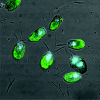Placing microalgae on the biofuels priority list: a review of the technological challenges
- PMID: 20031983
- PMCID: PMC2874236
- DOI: 10.1098/rsif.2009.0322
Placing microalgae on the biofuels priority list: a review of the technological challenges
Abstract
Microalgae provide various potential advantages for biofuel production when compared with 'traditional' crops. Specifically, large-scale microalgal culture need not compete for arable land, while in theory their productivity is greater. In consequence, there has been resurgence in interest and a proliferation of algae fuel projects. However, while on a theoretical basis, microalgae may produce between 10- and 100-fold more oil per acre, such capacities have not been validated on a commercial scale. We critically review current designs of algal culture facilities, including photobioreactors and open ponds, with regards to photosynthetic productivity and associated biomass and oil production and include an analysis of alternative approaches using models, balancing space needs, productivity and biomass concentrations, together with nutrient requirements. In the light of the current interest in synthetic genomics and genetic modifications, we also evaluate the options for potential metabolic engineering of the lipid biosynthesis pathways of microalgae. We conclude that although significant literature exists on microalgal growth and biochemistry, significantly more work needs to be undertaken to understand and potentially manipulate algal lipid metabolism. Furthermore, with regards to chemical upgrading of algal lipids and biomass, we describe alternative fuel synthesis routes, and discuss and evaluate the application of catalysts traditionally used for plant oils. Simulations that incorporate financial elements, along with fluid dynamics and algae growth models, are likely to be increasingly useful for predicting reactor design efficiency and life cycle analysis to determine the viability of the various options for large-scale culture. The greatest potential for cost reduction and increased yields most probably lies within closed or hybrid closed-open production systems.
Figures







Similar articles
-
Microalgal lipids biochemistry and biotechnological perspectives.Biotechnol Adv. 2014 Dec;32(8):1476-93. doi: 10.1016/j.biotechadv.2014.10.003. Epub 2014 Oct 14. Biotechnol Adv. 2014. PMID: 25449285 Review.
-
Theoretical Calculations on the Feasibility of Microalgal Biofuels: Utilization of Marine Resources Could Help Realizing the Potential of Microalgae.Biotechnol J. 2016 Nov;11(11):1461-1470. doi: 10.1002/biot.201600041. Biotechnol J. 2016. PMID: 27782372 Free PMC article.
-
Algal biofuels.Photosynth Res. 2013 Nov;117(1-3):207-19. doi: 10.1007/s11120-013-9828-z. Epub 2013 Apr 21. Photosynth Res. 2013. PMID: 23605290 Review.
-
Global evaluation of biofuel potential from microalgae.Proc Natl Acad Sci U S A. 2014 Jun 10;111(23):8691-6. doi: 10.1073/pnas.1321652111. Epub 2014 May 27. Proc Natl Acad Sci U S A. 2014. PMID: 24912176 Free PMC article.
-
Enhancing microalgal photosynthesis and productivity in wastewater treatment high rate algal ponds for biofuel production.Bioresour Technol. 2015 May;184:222-229. doi: 10.1016/j.biortech.2014.10.074. Epub 2014 Oct 24. Bioresour Technol. 2015. PMID: 25453429 Review.
Cited by
-
Unlocking nature's treasure-chest: screening for oleaginous algae.Sci Rep. 2015 Jul 23;5:9844. doi: 10.1038/srep09844. Sci Rep. 2015. PMID: 26202369 Free PMC article.
-
Astaxanthin-Producing Green Microalga Haematococcus pluvialis: From Single Cell to High Value Commercial Products.Front Plant Sci. 2016 Apr 28;7:531. doi: 10.3389/fpls.2016.00531. eCollection 2016. Front Plant Sci. 2016. PMID: 27200009 Free PMC article. Review.
-
The Use of Urea and Kelp Waste Extract is A Promising Strategy for Maximizing the Biomass Productivity and Lipid Content in Chlorella sorokiniana.Plants (Basel). 2020 Apr 7;9(4):463. doi: 10.3390/plants9040463. Plants (Basel). 2020. PMID: 32272580 Free PMC article.
-
Photosynthesis at the forefront of a sustainable life.Front Chem. 2014 Jun 12;2:36. doi: 10.3389/fchem.2014.00036. eCollection 2014. Front Chem. 2014. PMID: 24971306 Free PMC article. Review.
-
Maximizing Lipid Yield in Neochloris oleoabundans Algae Extraction by Stressing and Using Multiple Extraction Stages with N-Ethylbutylamine as Switchable Solvent.Ind Eng Chem Res. 2017 Jul 19;56(28):8073-8080. doi: 10.1021/acs.iecr.7b01032. Epub 2017 Jun 21. Ind Eng Chem Res. 2017. PMID: 28781427 Free PMC article.
References
-
- Anderson R. A. 2005. Algal culturing techniques. London, UK: Elsevier Science and Technology Books, Academic Press.
-
- Benemann J. R. 1999. Biological processes for the mitigation of greenhouse gases. In Conf. Proc. of the 4th Int. Conf. on Greenhouse Gases Control Technologies (eds Eliason B., Riemer P., Wokaun) A., pp. 689–693. Amsterdam, The Netherlands: Elsevier Science.
-
- Berberoglu H., Yin J., Pilon L. 2007. Light transfer in bubble sparged photobioreactors for H2 production and CO2 mitigation. Int. J. Hydrogen Energy 32, 2273–2285. (10.1016/j.ijhydene.2007.02.018) - DOI
-
- Bertram S. H. 1936. Elaidinization of oleic acid and cis–trans isomerism. Chem. Weekblad 33, 457–459.
-
- Bligh E. G., Dyer W. J. 1959. A rapid method of total lipid extraction and purification. Can. J. Biochem. Phys. 37, 911–917. - PubMed
Publication types
MeSH terms
Substances
LinkOut - more resources
Full Text Sources
Other Literature Sources

